Multi Container Pod

A pod is a group (sometimes of whales) of containers.
Does it mean that kubernetes is asking us to put multiple containers in a pod?

What Multiple Containers
- The
k8s Pods guide tells us that:
"A Pod models an application-specific "logical host": it contains one or more application containers which are relatively tightly coupled." - Somehow, the example of a web-server and a database server, that together form a web application (like wordpress site) is one of the first examples that come to mind.
BUT THIS IS AN ANTIPATTERS, THESE CONTAINERS SHOULD NOT RUN INSIDE A SINGLE POD. - The big thing, then, is understanding what coupled means. So ask yourself these questions:
- Is it true that those pods shouls ALWAYS run together?
- Is it true that these containers should run IN THE SAME NODE?
- Is there a one-to-one ratio of the numbers of these pods? We nay want to run several web servers, and use a load balancer to increase performance and taulerance for our web application. In the same time, we may choose running just a single DB server (or maybe 2 instances that backup each other).
- So what could be a good example of a multi-container-pod?
Sidecar Containers

- A sidecar container help the main container do its job (it does not do a completelly different job).
- Here's an example:
- Kubernetes collects logs of all pods.
- Logs are text that is written to the standard output in containers
- It turn out that the best practice would be to write log messages to standard output,
BUT NOT TO A LOCAL FILE!! - You can view them by using the kubectl logs command.
- Let's say you got an server code that writes everything to a local file, and you want to run it as a container in kubernetes.
You could run another container that will monitor the local file, and write everything to the standard output.
THIS IS A GOOD EXAMPLE FOR ANOTHER CONTAINER IN THE SAME POD!
Sidecar Container - Example
- Here's out pod configuration, with both containers:
1$> cat multi-container.yaml
2apiVersion: v1
3kind: Pod
4metadata:
5 name: multi
6spec:
7 containers:
8 - name: busybox1
9 image: busybox
10 command: ['sh', '-c', 'COUNTER=0; while true; do printf "line: $COUNTER\n" >> /output/output.log;sleep 1;$(()); COUNTER=$((COUNTER + 1));done']
11 volumeMounts:
12 - name: sharedvol
13 mountPath: /output
14 - name: busybox2
15 image: busybox
16 args: ['sh', '-c', 'tail -f /output/output.log']
17 volumeMounts:
18 - name: sharedvol
19 mountPath: /output
20 volumes:
21 - name: sharedvol
22 emptyDir: {}
- Note that both container mount a shared volume (called sharedvol)
- One container write multiple lines into a file called /output/output.log
- The other container writes each line of this file to the standard output using the tail -f linux command.
- Try this, and use kubectl logs multi -c busybox2 to see those logs.